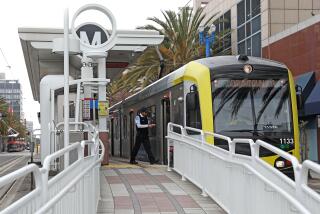Parts of Washington’s Subway Tracks Sinking : Capital’s Metro Line Beset by Flattening Shock Absorbers Underneath Rails
- Share via
WASHINGTON — Portions of the capital’s $5-billion Metro subway system are sinking.
According to officials of the Metro, 2.7-miles of track on the system’s 30.7-mile Blue Line have subsided as much as 1 1/2 inches at or near five stations in Washington and one stop in neighboring Arlington County, Va.
The cause, the officials said, is the flattening of polyurethane shock absorbers beneath the rails--engineers call them “doughnuts.”
The doughnuts are designed to absorb train noise and vibrations that could interfere with sensitive medical and scientific equipment on the surface or cause cracks in subway structures and buildings.
Officials say they do not know what is causing the “doughnuts” to go flat.
The 70-mile Metro system, which is still under extensive construction, has been operating since 1976 throughout the District of Columbia and into the suburbs in adjacent Maryland and Virginia.
No Loss of Function
The sinking of the tracks is causing no noise or safety hazard and is not slowing the trains, said Metro spokeswoman Marilyn Dicus. She also said that the flattened doughnuts still function at full effectiveness.
She added, however, that in several spots the devices “have compressed enough to cause us concern.” Engineers say that the tracks could continue to sink in some locations as the doughnuts compress, she said.
Dicus said the shock absorbers do look like “large bagels.” Each is 6 inches in diameter and 3 inches thick, with a 2-inch hole in the center. They are made of a flexible polyurethane.
Other doughnuts used in the system, made of Fiberglas or rubber, are not going flat, she said.
In a worst-case scenario, defective doughnuts could, over time, allow vibrations that might produce cracking and eventual collapse of an adjacent Metro platform or mezzanine or an above-ground structure, engineers outside the Metro system say.
Dicus said that subways in several cities--including Toronto, London, Boston and Buffalo--have similar shock-absorbing systems.
Metro spokesmen refused to identify the name of the manufacturer or the prime contractor responsible for installing the doughnuts. They said they did not want to tip the companies off before Metro officials can question them about the problem.
Contractors Questioned
Other Metro employees provided the names of contractors on the sinking line, but two contractors who were contacted said they had not worked on the installation at the affected stations.
Dicus said that the doughnuts are supposed to spring back to shape after a train passes over them, but they are failing at or near the Foggy Bottom, L’Enfant Plaza, Federal Center Southwest, Capitol South and Potomac Avenue stations in Washington and at the Rosslyn station in Arlington.
(The Foggy Bottom stop serves the State Department complex; Capitol South serves Capitol Hill and surrounding federal offices.)
She said Metro engineers think the doughnuts should have lasted at least 30 years, but the flattening was first spotted seven years ago and was corrected with routine maintenance.
Dicus said engineers did not know at what point of compression the cushions would cease to prevent noise and vibration.
Metro officials said there is no evidence anywhere in the system of excessive noise or vibration. The system, like similar structures, is engineered for movement so that vibration would not cause cracking, Dicus said. Also, she said, the system is inspected daily for any potential safety problem.
Solution Not Yet Set
She said that some Metro officials have speculated that a manufacturing error may be the cause of the problem, and Metro is conducting tests to determine what corrective actions need to be taken.
The cost of correction has not yet been estimated, Dicus said, because Metro officials do not know how extensive the corrections will be.
No decision has been made to replace any of the doughnuts, she said.
Replacement, she said, would be a “major operation” that presumably would be expensive. It would involve cutting the rail, lifting the concrete beneath it, placing new doughnuts under the slabs and reclosing the railbed.
Metro officials said the concrete sections above the doughnuts--called “floating slabs”--are 14 inches thick, with widths of up to slightly over 11 feet. Most are 25 or 50 feet long, and some are as long as 70 feet.
More to Read
Sign up for Essential California
The most important California stories and recommendations in your inbox every morning.
You may occasionally receive promotional content from the Los Angeles Times.










